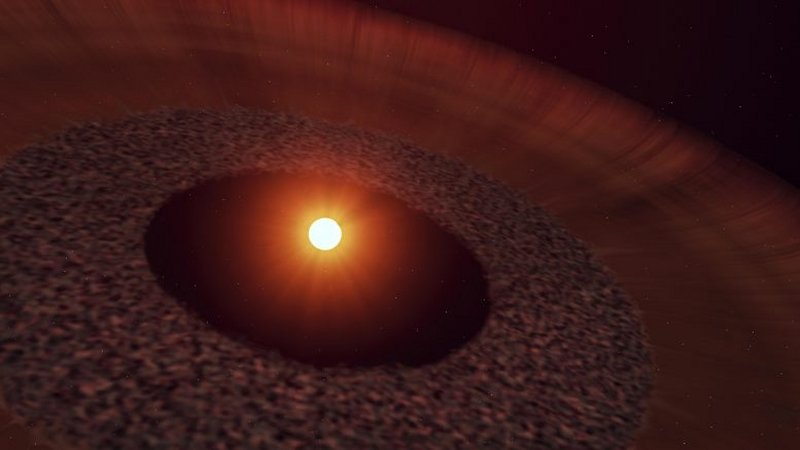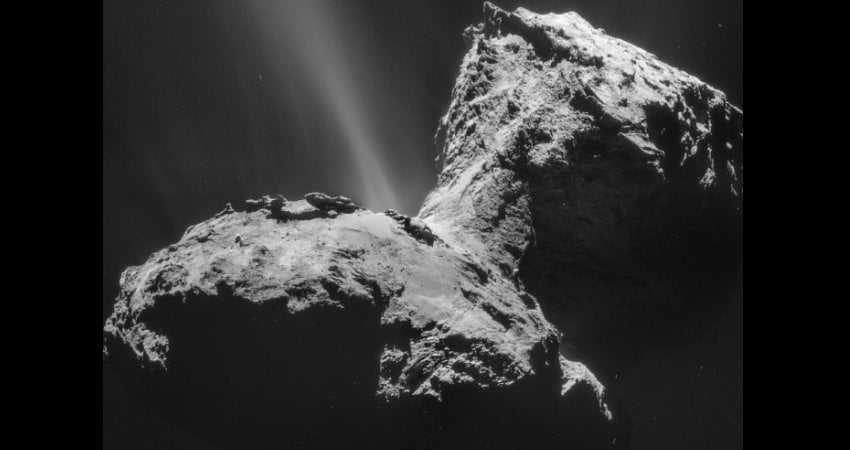Fast-Moving Gas Flowing Away From Young Star Observed – Rare Detection
Eddie Gonzales Jr. – MessageToEagle.com – A unique stage of planetary system evolution has been imaged by astronomers, showing fast-moving carbon monoxide gas flowing away from a star system over 400 light-years away.
 Artist’s impression of the system, with the star at the center, and the inner dust belt from which gas is produced and dispersed outwards to the far reaches of the system. Credit: Institute of Astronomy, University of Cambridge
Artist’s impression of the system, with the star at the center, and the inner dust belt from which gas is produced and dispersed outwards to the far reaches of the system. Credit: Institute of Astronomy, University of Cambridge
Astronomers led by the University of Cambridge, have detected fast-moving carbon monoxide gas flowing away from a young, low-mass star: a unique stage of planetary system evolution which may provide insight into how our own solar system evolved and suggests that the way systems develop may be more complicated than previously thought.
The detection was made with the Atacama Large Millimeter/submillimeter Array (ALMA) in Chile, as part of a survey of young ‘class III’ stars, reported in an earlier paper.
Some of these class III stars are surrounded by debris disks, which are believed to be formed by the ongoing collisions of comets, asteroids, and other solid objects, known as planetesimals, in the outer reaches of recently formed planetary systems.
The leftover dust and debris from these collisions absorbs light from their central stars and re-radiate that energy as a faint glow that can be studied with ALMA.
In the survey, the star in question, ‘NO Lup’, which is about 70% the mass of our sun, was found to have a faint, low-mass dusty disk, but it was the only class III star where carbon monoxide gas was detected, a first for this type of young star with ALMA.
While the detection of carbon monoxide gas is rare, what made the observation unique was the scale and speed of the gas, which prompted a follow-up study to explore the star.
“Just detecting carbon monoxide gas was exciting, since no other young stars of this type had been previously imaged by ALMA,” said first author Joshua Lovell, a Ph.D. student from the Cambridge’s Institute of Astronomy, in a press release.
“But when we looked closer, we found something even more unusual: given how far away the gas was from the star, it was moving much faster than expected. This had us puzzled for quite some time.”
Grant Kennedy, Royal Society University Research Fellow at the University of Warwick, who led the modeling work on the study, came up with a solution to the puzzle.
“We found a simple way to explain it: by modeling a gas ring, but giving the gas an extra kick outward,” he said.
“Other models have been used to explain young disks with similar mechanisms, but this disk is more like a debris disk where we haven’t witnessed winds before. Our model showed the gas is entirely consistent with a scenario in which it’s being launched out of the system at around 22 kilometers per second, which is much higher than any stable orbital speed.”
Further analysis also showed that the gas may be produced during collisions between asteroids, or during periods of sublimation—the transition from a solid to a gaseous phase—on the surface of the star’s comets, expected to be rich in carbon monoxide ice.
“This fascinating star is shedding light on what kind of physical processes are shaping planetary systems shortly after they are born, just after they have emerged from being enshrouded by their protoplanetary disk,” said co-author Professor Mark Wyatt, also from the Institute of Astronomy.
“While we have seen gas produced by planetesimals in older systems, the shear rate at which gas is being produced in this system and its outflowing nature are quite remarkable and point to a phase of planetary system evolution that we are witnessing here for the first time.”
Further detailed modeling will be required.
Written by Eddie Gonzales Jr. – MessageToEagle.com Staff










